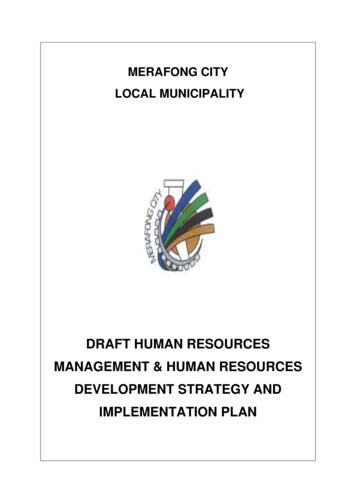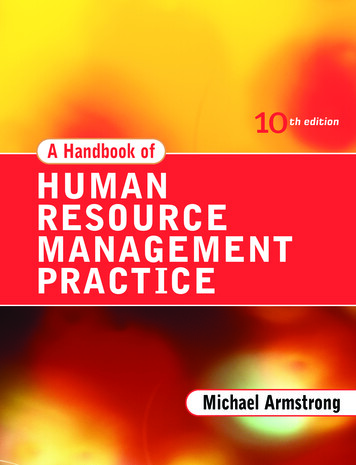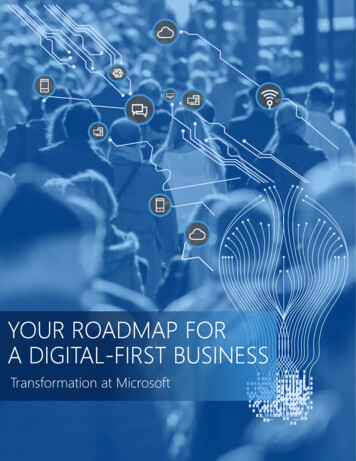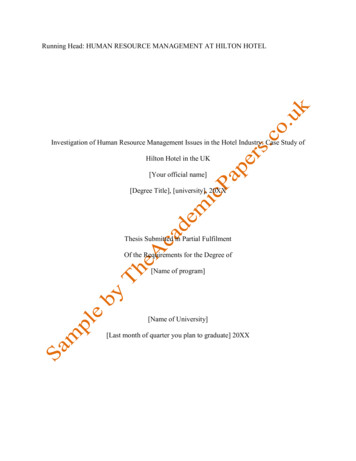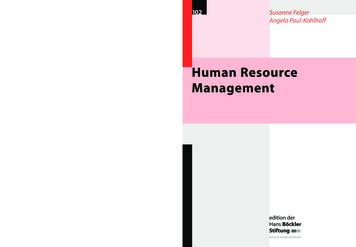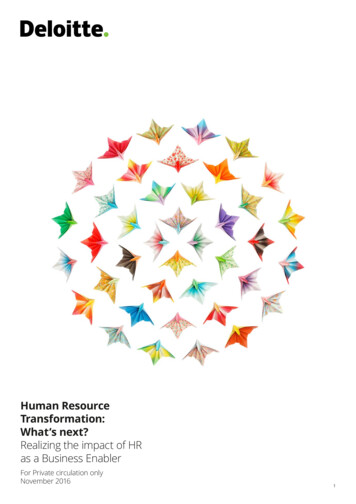
Transcription
Human ResourceTransformation:What’s next?Realizing the impact of HRas a Business EnablerFor Private circulation onlyNovember 20161
Human Resource Transformation: What’s next? Realizing the impact of HR as a Business EnablerPrefaceHR transformation has evolved significantlyover the past decade along with thechanging business environment andchallenges—in India and around the world.Historically, mature HR teams and functionshave focused on improving operatingefficiency and administrative effectiveness.Today, such improvements are table stakes.To have an impact, HR must developadvanced capabilities to align HR structureand services with the business needs thatfacilitate business growth and operationalexcellence. Advanced HR capabilitiesenable an organization to execute itsbusiness strategy more effectively andimprove performance across the entireenterprise — not just within the HRfunction.percent of revenue — to tomorrow’s focuson building strategic business servicesthat can help drive value (including shareprices and contributions to employeesand communities). The coming decade willprovide HR with significant opportunitiesto help make a difference to the company;it will be interesting to see how HR stepsup to the challenge, and we look forward topartnering with you on these challengesThis survey was conducted to assess thecurrent maturity of Indian organizations totake on HRT initiatives and the compellingreasons for the same. We believe thatseveral survey findings resonate with theglobal HR Transformation trends while atthe same time, certain developments areunique to the Indian business context.In recent years, HR Transformation has ledto a major restructuring of HR operationsand processes — transforming the wayHR services are delivered. Yet there isstill much work to do. Companies todayface significant HR challenges that barelyexisted a few years ago. We believe thatNext Generation HR Transformation willrequire a significant change from today’sfocus on HR operations — which aretypically budgeted at 0.5 percent to 0.7Finally, HR transformation programscontinue to evolve rapidly as companiesembrace digital business and HR includingcloud, mobile, analytics, and automationtechnologies. We hope that the reportenables you to evaluate your ongoing andplanned HR Transformation initiatives andaccomplish your objectives to improve HR,employee, and business performance.Debabrat MishraPartner, Human Capital,Deloitte Touché Tohmatsu India LLPmdebabrat@deloitte.comSucheta HotaDirector, Human Capital,Deloitte Touché Tohmatsu India LLPsuhota@deloitte.comMohinish SinhaPartner, Human Capital,Deloitte Touché Tohmatsu India LLPmohinishsinha@deloitte.comPooja BajpaiDirector, Human Capital,Deloitte Touché Tohmatsu India LLPbajpaip@deloitte.com3
Human Resource Transformation: What’s next? Realizing the impact of HR as a Business EnablerHuman Resource Transformation: What’s next? Realizing the impact of HR as a Business EnablerContent4About the Survey6Survey Demographics8Fast Facts: HR Transformation10Theme 1: HR specialists have developed tounderstand business issues12Theme 2: Building HR capability and HR ServiceDelivery Effectiveness are key components of thenext phase of HR Transformation16Theme 3: Revolutionizing employee experiencethrough digital28Conclusion: From efficiency to businessenablement to digital (HR) business32Deloitte’s Human Capital Practice33Deloitte’s Human Capital Eminence and Research34About Deloitte36Authors40Contacts425
Human Resource Transformation: What’s next? Realizing the impact of HR as a Business EnablerHuman Resource Transformation: What’s next? Realizing the impact of HR as a Business EnablerAbout the SurveyObjectiveThe objective of this survey is to developa distinct point of view to showcaseopportunities for HR to drive sustainablebusiness impact and co-create value tobusinesses operating in and from the Indiamarket.Our research uncovered Six (6) EssentialHigh-Impact HR Design Principles for nextgeneration HR Transformation-- decodingthe desired business impact of HR ServiceDelivery for value realization.Keeping this in mind, Deloitte conductedits second national survey to understandhow companies in India are bringing HRinto the 21st century and understand howHR functions and leaders are approachingtransformation across the country.Focus Areas:The macro challenges faced by organizations today have clear business implications thatcan help or hinder strategic objectives.6 EssentialHigh-Impact HRDesign PrinciplesBusiness Challenges1Start with foundationinclusive of analyticsand empowermentculture in HR2Mirror businessstrategy4Coordinate effortsacross theorganization – frontlinedecision making andinformation sharing6Move towardsdigitization andautomation throughdesign thinking6Customer supplierrelationshipchangesNeed to centralize/standardize processesContinued focuson growthorganic/inorganicLegislativechangesKey Considerations For Organizations3Leveraging principles1-4 to optimizebusiness leadership,manager people skills andHR performanceRapid changein technologyHeightened emphasis onquality and standardsBuild structure thatoptimizes businessembedded design anddelivery while leveragingHR specialist expertise5Rising laborcostsHow do I improve myoperating costs?How effective aremy currentprocesses ortechnology?How do I align supplywith variable demand?How do we work acrossdifferent subsidiaries?How do I align myHR strategy withbusinessrequirements?What will it take toimprove middle/backoffice operations?How am I chargedfor service?Desired OutcomesFinancial savingsComplianceBusiness continuity planStrong Customer RelationshipsBPRFlexible InfraAccess to trained resourcesLeaner processes and policiesIntegrated systems7
Human Resource Transformation: What’s next? Realizing the impact of HR as a Business EnablerHuman Resource Transformation: What’s next? Realizing the impact of HR as a Business EnablerSurvey DemographicsParticipant ProfileThis HR Transformation survey reportpresents the results of more than 75 HRleaders across various industries acrossIndia. This year, we saw representationacross varied industry segments,with dominant participation fromManufacturing, Technology, Media andTelecommunications, and Energy andResources industries. A representativesample of small, medium, and largeorganizations was taken.We would like to thank all the participantswho completed the survey.Figure 3: Industry DistributionManufacturingFigure 1: Organization type22%31%MNCIndian MNCIndian BusinessHouseGovernment /Public SectorUndertaking4%Global In-Housecenters/ CaptiveShared ServicesCenters4%5%Others34%33%Technology, Media &Telecommunications13%Energy & Resources13%Services9%Financial Services9%Consumer Business9%5%OthersLife Sciences &Health Care4%Lifesciences andhealthcare2%Banking &Securities2%Transportation2%Figure 2: Geographic Presence16%26%Only in India16 Countries2-5 Countries6-15 CountriesFigure 4: Company Annual Revenue5001-10000 Crs2501-5000 Crs1001 - 2500 Crs27% 1000 Crs36%9%20%35%31%89
Human Resource Transformation: What’s next? Realizing the impact of HR as a Business EnablerHuman Resource Transformation: What’s next? Realizing the impact of HR as a Business EnablerHR Transformation70 percent of organizations haveFast Facts: HRTransformationin India70%indicated that they have initiated an HRTransformation initiative. More than 60percent of the remaining organizations areplanning a transformation initiative in thenext 2 yearsHR, a Cost driver to a strategic business partner55%increasingly global and competitive andstriving to keep pace with the best-in-classindustry practices, HRT is being realizedas a key enabler by C-Suite leaders inIndia to enhance the HR service deliveryeffectiveness and position HR as businessenabler.The findings of the survey illustrates someof the emerging trends of HRT in India.Below are key highlights.55%Building HRCapabilitiesIn 2016, 36 percent cite ‘efficiency in HR costs’ and 14 percentcite ‘compliance’ as drivers leading to a HR transformation incomparison to 65 percent and 41 percent in 2012, respectivelyDid you know?HRT has evolved significantly in India overthe past few years. For more than a decade,large global companies have looked totransform HR to improve alignment withbusiness needs. Deloitte’s India HRT Survey2016 is the second edition in this series,a leadership guide to help executivesnavigate the demands of HR interventions.75 organizations participated in this surveyfrom diverse industry segments highlightsinteresting insights and trends of HRT inIndia. As Indian companies are becomingEffectivenessof HR ServicesShape Culture, Drive Strategy79%Organizations have initiated HRTefforts around restructuring HRorganizations61%Organizations havea focus on changingorganization cultureNew MandatesA downward trend hasbeen seen in the focuson restructuring theHR Shared Services(from 57 percent to 41percent)10New mandates are on thehorizon including the focuson digital solutions, designthinking, and incorporateautomation in HR processesand systems11
Human Resource Transformation: What’s next? Realizing the impact of HR as a Business EnablerHuman Resource Transformation: What’s next? Realizing the impact of HR as a Business EnablerHR specialistshave developedto understandbusiness issuesHuman Resources at a turning point?HR is at a crossroads. Once designedprimarily as an administrative andcompliance function, today’s HRorganization must be closely integratedwith the business. Changing businessimperatives demand not only a neworganizational model for HR itself, but also amassive reskilling of HR professionals. Thispresents an unprecedented opportunityfor HR to play a leading role at the highestlevels of business strategy, execution, andresults.Evolving role of HRMore than three quarters (76 percent) ofrespondents to our 2016 recognize that HRexecutives have a strong understanding oftheir businesses, competitors, and externalenvironments. As HR gains credibility ininfluencing key business decisions, thisfinding confirms HR’s central role to partnerwith the business in managing businessrelated risks.In addition, while HR is embedding itselfin the business, the role of HR businesspartners needs to be re-defined.Increasingly, there is a pertinent need forthe business partner role to have a greaterimpact on the business activities. 72percent of the respondents report businesspartners are playing a strategic advisoryrole in developing and implementingstrategies aligned to meet businessobjectives. However, many organizationscontinue to struggle to understand howHR business partners should contributeto the business. According to the 2015Deloitte HR Business Partnering Report2,this may be due to a mismatch of currentHR professionals’ capabilities with whatis required for the business partner role.Moreover, the maturity level of many HRfunctions is still not at point where businesspartners can fully take advantage of theirHR service delivery model.Moreover, Centers of Excellence (CoEs)are playing a major role in shaping the HRstrategy for organizations. 62 percent ofthe respondents reported that CoEs intheir organization are working on strategicinitiatives which are aligned to the businessimperatives. ‘Centers of Excellence’ areevolving to ‘Communities of Expertise’.These communities are enterprise-widenetworks with a combination of centralizedand business embedded resources chargedwith the developing and applying deepfunctional HR knowledge. Earlier COEsfocused on pushing policies and programsinto the business; now they are adaptingto the changing business needs, withcontinued focus on addressing emergingbusiness priorities and actively interactingwith business leaders and employeesat many levels and across divisions andgeographies.Figure 5: HR professionals have a strong understanding of thebusiness, competitors, and the external business environmentStrongly Agree21%Agree55%Slightly AgreeSlightly DisagreeDisagree17%2%4%30%Agree32%Slightly AgreeSlightly DisagreeDisagreeStrongly Agree30%Agree32%Slightly AgreeSlightly DisagreeDisagree26%11%22%offerings, eliminating and transitioningas much operational work as possible.Organizations realize that if the traditionalscope of HR shared services is limited toadministrative work, it will be destined tofocus on the lower value efficiency gains.There is a need to transition administrativework to shared services and operationscenters and then proceed to find ways todigitize, automate, and streamline theseactivities to the fullest extent possible.Running HR like a commercialenterpriseAlmost 1 out of 2 (49 percent) of therespondents reported HR shared servicesshould further expand their businessFigure 6: HRBPs partner well with the businessStrongly AgreeFigure 7: CoEs focus solely on strategic initiatives26%11%22%Deloitte HR Business Partnering Report, 2015 ocuments/financialservices/za humanresources business partnering 20 jan 2015.pdf21213
Human Resource Transformation: What’s next? Realizing the impact of HR as a Business EnablerHR Operating Models are in a state offluxDeloitte’s focus since 2014 has been on anapproach we refer to as High-Impact HRoperating models3 - but have organizationsreally been able to shift to a new level ofmaturity? Professors Dave Ulrich, WayneBrockbank, and their many professionalcolleagues helped set the direction fortransformation of HR. Organizationshave also been transforming HR for morethan 20 years now. Today’s HR functionsare facing a new set of challenges.Organizations now expect HR not onlyto be efficient in delivering core servicesbut also to set a talent agenda for drivingperformance and engagement. HR mustsupport and drive a range of businessinitiatives. Thus, the HR operating modelmust be able to evolve constantly andrespond to new business challengesincluding innovation, transformation, anddigital strategies.HR roles that are a part of arestructured organizationWhen we conducted the HRT survey in20121, 43 percent of the respondentsindicated that restructuring the HRorganization was one of the key activitiescarried out in HR interventions. Moreover,57 percent indicated restructuring HRshared services was one of their main areasof work during HR re-organization followedHuman Resource Transformation: What’s next? Realizing the impact of HR as a Business Enablerby restructuring the roles of HRBPs andCOEs. In this year’s survey, a growing trendtoward increasing alignment betweenbusiness and HR (68 percent) is a key focusarea, as seen in Figure 8.Moreover, as seen in Figure 8, CoEshave gained a wider acceptance, andrestructuring roles within CoEs (from 32percent in 20121 to 57 percent in 2016)will grow, as organizations continue totransform HR by focusing capabilities withincenters of excellence. CoEs will drive leadingpractices and processes by embeddingdeep, functional HR knowledge, strongunderstanding of the business issues, andmarket trends.Figure 8: HR roles that are a part of the restructured organizationHRBP Generalists68%HR Centers ofExcellence57%HR Shared Services/ HR OpsHR IT Part of HRShared Services41%14%Deloitte High Impact HR Operating Model Report, 2014 pdf31415
Human Resource Transformation: What’s next? Realizing the impact of HR as a Business EnablerHuman Resource Transformation: What’s next? Realizing the impact of HR as a Business EnablerBuilding HR capabilityand HR Service DeliveryEffectiveness are keycomponents of thenext phase of HRTransformationThe imperatives of efficiency and costreduction have always been part of theHR mandate. Initially focused on makingHR operations more efficient and effectivethrough process standardization andtechnology, the next generation of HRtransformation is more tightly linked tobusiness strategy, results, and impact. It isan enabler to create business value throughHR initiatives that address a company’smost pressing strategic challenges. Thatmeans anticipating critical workforce trends,shaping and executing business strategy,identifying and addressing people-relatedrisks and regulations, enhancing workforceperformance and productivity, and offeringnew HR initiatives to help a company improveand grow. Typical HR challenges revolvearound overlapping HR processes, systemsand structure that are not comprehensive innature and are not designed to support theglobal organization and its planned growth.Developing Leaders79%Productivity & PerformanceManagement68%Data Management &Analysis45%Employee AttritionComplaince & RiskManagementIn this year’s survey, when asked aboutcurrent challenges being faced byorganizations, the top three emergingchallenges (Figure 9) – ‘ developing leaders’,‘productivity and performance management’and ‘data management and analytics’ arein line with the global findings of the 2016Deloitte Human Capital Trends Report5.Developing leaders: Still a recurrentissueThe leadership challenge in organizationshas grown to a crisis level. Increasinglycompanies rate this issue as important orvery important. Nor is this surprising, as thechallenges are immense.Productivity and managingperformance: Reinventing HRIn Deloitte’s Global Human CapitalTrends Report 20165, the percent of therespondents rating HR’s performanceas ‘good’ or ‘excellent’ has been trendingupwards over the past few years. 60 percentof the respondents believe HR is innovatingand beginning to reskill in order to delivergreater business impact and drive businessinnovation.Data Management and Analytics:Gaining speed‘People analytics’ refers to using peoplerelated data to bring together HR andbusiness data from different partsof the business – as well as externaldata-- addressing various HR challenges:performance management, compliance risks,employee engagement, leadership pipelineand culture. Analytics can now be embeddedin most ERP and talent managementsystems. Driven by competition for bothcustomers and talent, organizations now areaggressively investing in data managementand analytics.function and leaders want to know howthey are performing. This requires theuse of a variety of measurement tools tomonitor the effectiveness and efficiency ofHR organizations and a drive for continuousimprovement efforts. Organizations areusing performance metrics and ServiceLevel Agreements as governance andmanagement tools. It is interesting to notethat 83 percent of organizations havepre-defined SLAs and KPIs for processperformance management even though 68percent of them indicate productivity andperformance management is a challenge.To meet these challenges companies mustreinvent their HR practices and relookat people management and evaluationthrough new strategies for leadership,talent, and data analytics.4Figure 9: HR challenges faced today38%30%Simplificationof Workon the external sector, continual growth inconsumer spending, fostered by favourabledemographics, moderate inflation, andstrengthening investments are expected tofuel continuing growth. These organizationsexhibit confidence in their HR capabilitiesrelative to survey respondents globally,however, the state of complexity in terms ofthe work environment, business practicesare still discouraging.Leadership challengeremains: In 20164, 68 percentof respondents across Indiaare still not confident on their In Deloitte’s 20165 Globalleadership bench strengthHuman Capital Trends Reportonly 5 percent rate theirIn the India Human Capital Trends Reportorganizations HR performance In Deloitte’s 20165 Global2016 , 88 percent of the respondents stillbelieve building a leadership pipeline is aas ‘excellent’ globallyHuman Capital Trendscontinued strategic priority, with only 50report, 77 percent ratepercent ready to tackle this challenge. 68HR organizations are largely being operatedpeople analytics as a keypercent respondents across India are stilland managed like any other businessThis survey revealed several HR challengesas seen in Figure 9, the top three challengeshave been elaborated below.Learning &DevelopmentWhat are the top three challenges HRfunctions face today?According to the 2016 Global Human CapitalTrends: India Report4, over 75 percent of theIndian organizations are optimistic aboutthe future. With 46 percent respondentswitnessing a growth of more than 10 percentthis year, India’s economy appears to beon track to be one of the fastest growingeconomies in the world in the coming year.Resilient domestic demand, limited reliancenot confident about their leadership benchstrength. The majority of respondents havenot reviewed or are currently reviewingtheir leadership development strategy withonly 30 percent having made high valueinvestments.Fig 10: SLA / KPI for process andperformance managementNo28%17%13%Yes83%Deloitte Human Capital Trends India Report, 2016 y2016-noexp.pdf4Deloitte Global Human Capital Trends Report, 2016 tal-trends-2016.pdf51617
Human Resource Transformation: What’s next? Realizing the impact of HR as a Business EnablerWhere are we on the HRT journey?Out of the companies surveyed, 70percent have undertaken HRT initiativesin the last 5 years, suggesting that HRorganizations are realizing the value thatHR can provide to business in terms ofcost savings and improving operationaleffectiveness; this has largely been theresult of a focus on standardizing HRsystems and processes, implementingshared services, and outsourcing andgetting started on analytics and newdigital platforms and applications.Among the rest, more than 60 percentrespondents have indicated plans toinitiate HR transformation initiatives overthe next two years. It is interesting tonote that 72 percent of the respondentsare managing their transformed HRprocesses internally in comparison toonly 46 percent in 20121. The increasecan be contributed to the specialised,home grown infrastructure andfacilities that these organizations haveinvested in to manage their HR systems.Organizations have identified avenuesfor optimization through employee selfservice, shared services, outsourcingand hybrid delivery models.One in five respondents (21 percent)have selectively outsourced certaintransactional, lower-value add activitiesto ensure core HR teams remainedfocused on key strategic imperatives.Organizations are now re-evaluating theservices they are willing to retain versusoutsource based on their organizationalcapabilities as they better understandthe service delivery implications. Thetailored strategy will result in a morepragmatic approach, a more realisticsolution and better HR outsourcingoutcomes. Organizational dynamics andculture will often significantly drive thetypes of services that can be successfullyintegrated into the retained organization.Of the organizations who haveundertaken HR transformation in18the past 5 years, only six percentorganizations believe that thetransformation efforts have not reachedthe expected satisfaction levels (Figure12). These organizations face impendingchallenges in defining the SLA / KPIsaround productivity and performancemanagement, along with managingdata effectively. Organizations citedinefficiency in the current model,lack of ability to effectively scale tomeet organization needs, along withincreased complexity, and poor vendormanagement as reasons for not beingable to meet the desired objectives.It is interesting to note that organizations(30 percent) that have not undergoneany HR transformation face slightlydifferent challenges than thoseorganizations that have commenceda transformation. Productivity andperformance management (79 percent)is the top concern for organizations whohave not undergone any transformationinitiative (Figure 15). Moreover,simplification of work (43 percent) andemployee attrition (36 percent) areother areas that require attention.Furthermore, development of theleadership pipeline (Figure 14 and 15)continues to remain the most pressingchallenge faced by all organizations.Beyond back office basicsThe survey shows that HRtransformation efforts are moregeared toward specific HR operationalpriorities rather than larger strategicplans. The scope of HR transformationinitiatives has evolved, where mostof the organizations are focusing onreinventing the HR function. In 2016, 79percent of the respondents commentedthat restructuring HR specifically isone of the most important triggersto transformation as opposed torestructuring the company as a whole(43 percent in 20121) or standardizing HRactivities (86 percent in 20121).Human Resource Transformation: What’s next? Realizing the impact of HR as a Business EnablerFigure 11: Have you undertaken anyHR Transformation initiatives in thepast 5 years?Figure 14: Key challenges faced by organizations after commencing HR transformationDeveloping Leaders82%Productivity &PerformanceManagementData Management &AnalysisNo30%64%52%Employee Attrition39%Learning &DevelopmentYes70%33%Simplificationof WorkComplaince & RiskManagementFigure 12: What is the level ofsatisfaction achieved from thetransformation initiatives?Did Not MeetExpectations6%24%21%9%Figure 15: Key challenges faced by organizations that havenot commenced any HR transformationProductivity &PerformanceManagementDeveloping Leaders79%71%Simplificationof Work70%ExceededExpectations43%36%Employee AttritionMet ExpectationsFigure 13: When is the next plannedHR Transformation initiative in yourorganization?Planned in Next24 MonthsData Management &Analysis29%Learning &Development21%Complaince & RiskManagement21%Figure 16: Nature of HR transformation undertakenPlannedin Next 36Months14%36%Restructure HROrganization79%Standardize HR70%Change OrganizationCulture61%Implemement ITPlatform50%Planned in Next12 MonthsUpgrade HRStaff55%36%19
Human Resource Transformation: What’s next? Realizing the impact of HR as a Business EnablerGrowth of Shared Services to improveHR service delivery effectivenessOrganizations originally implemented HRShared Services in response to optimizingHR service delivery and enhancingcustomer experience. As we move towardglobalization, a virtual workforce, and theneed to support global talent strategies, therole of HR Shared Services also has begunto evolve. There are numerous benefitscited by organizations for implementingShared Services. In Deloitte’s Global SharedServices Survey (2011), over 85 percentof organizations agreed cost reduction,level of controls, and process efficiencieswere the top three benefits of adopting aShared Services Centre (SSC). However, inthe recent Global Shared Services survey(2015)6, majority of respondents recognizedthat cost savings are not the sole focusof a SSC adoption; while business unitscontinue to focus on basics, they are alsofacilitating transition into higher value addedservices including leveraging Six Sigma, LeanMethodologies, Predictive Analytics, etc.,to improve performance and results—notsimply lower costs.What are the key drivers for HRTransformation going forward?HR Shared Services expands upon thetraditional model to include the deliveryof inquiry, transactional, and specialtyservices with a focus on customer service,operational excellence, and continuousimprovement. In this survey, improvingservice delivery effectiveness (55 percent)and building HR capability (55 percent)have retained their positions as thetop two primary goals for initiating HRtransformation. However, there is a dropin percentage compared to 20121, where alarger percentage of organizations (over 80percent) agreed that these two drivers weremost vital.Also, it is interesting to note somechanges among the other key drivers. 42percent of the surveyed companies arelooking at transforming HR as a part ofcorporate restructuring and 36 percentorganizations feel rapid growth andefficiency in cost are other key goals ofinitiating HR transformation interventionsHuman Resource Transformation: What’s next? Realizing the impact of HR as a Business EnablerFigure 17: Key drivers for HR transformationEffectiveness Service55%Build HR Capability55%CorporateRestructuring42%Rapid Growth36%Efficiency HR Cost36%Free HR ForStrategic Work33%Part of LargerCorporate 6%3%3%(Figure 17). Moreover, compliance whichwas another key driver in the 20121 survey,shows a drop by 29 percent this year. Thisindicates that the HR function is largelymoving toward increasing alignment withthe business objectives. The next phase ofHR transformation necessitates achievinghigher efficiency on enhanced service levels.From being compliance driven and ensuringcost efficiency HR services are now a partof larger corporate efforts, which are morestrategic in nature leading to enhancedcustomer (employee) experience.As Shared Services organizations matureover time, organizations have moved tocombine other functional areas into onecomprehensive shared services strategyand approach. This allows organizationsto reduce their operating costs furtherand helps provide a consistent employeeexperience across all functions, regardlessof the source of the inquiry or transaction.HR Shared Services has traditionally focusedon highly transactional services, but hasrecently evolved to incorporate interactiveand knowledge-oriented services. Theskills and experiences required for HRShared Services staff have also evolved tosuccessfully deliver a more robust suite ofservices to the business.Obstacles in the current HR servicedelivery modelHR Shared Services key roles must beorganized in a way that optimizes thedelivery of service and enhances theemployee experience.Over 80 percent organizations in thesurvey cited ability to effectively scale tomeet the needs of their organiza
Partner, Human Capital, Deloitte Touché Tohmatsu India LLP mdebabrat@deloitte.com Mohinish Sinha Partner, Human Capital, Deloitte Touché Tohmatsu India LLP mohinishsinha@deloitte.com Sucheta Hota Director, Human Capital, Deloitte Touché Tohmatsu India LLP suhota@deloitte.com Human Resource Transformation: Whats next?


